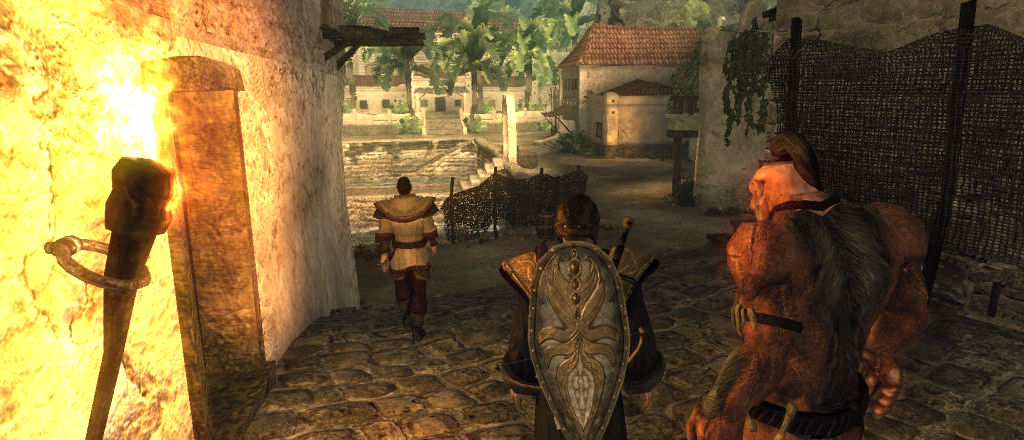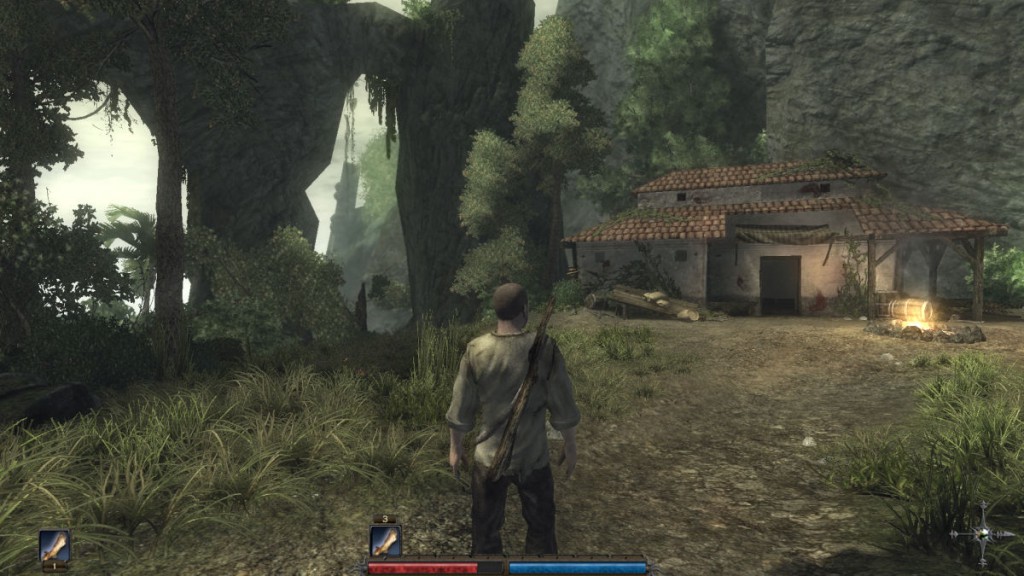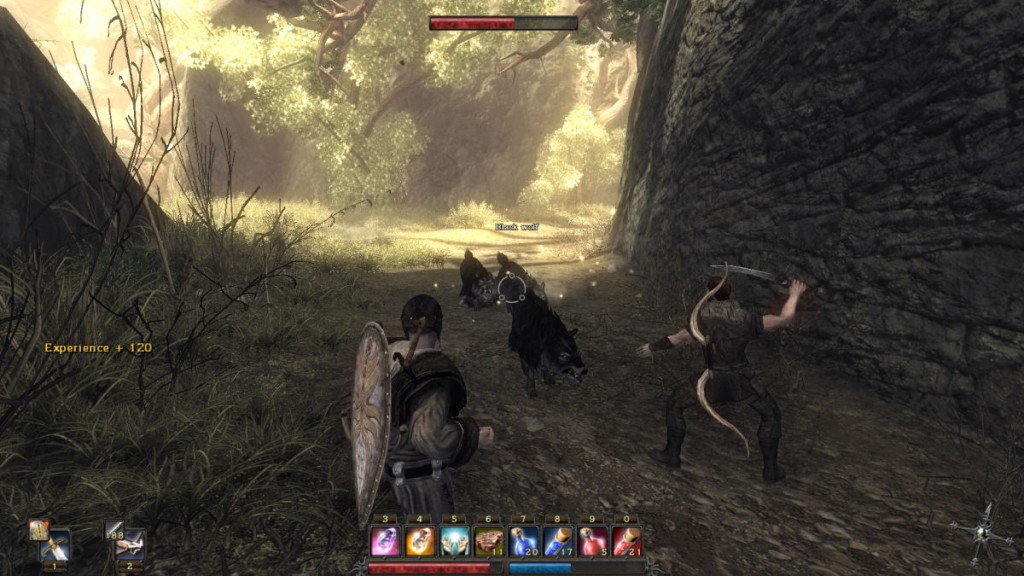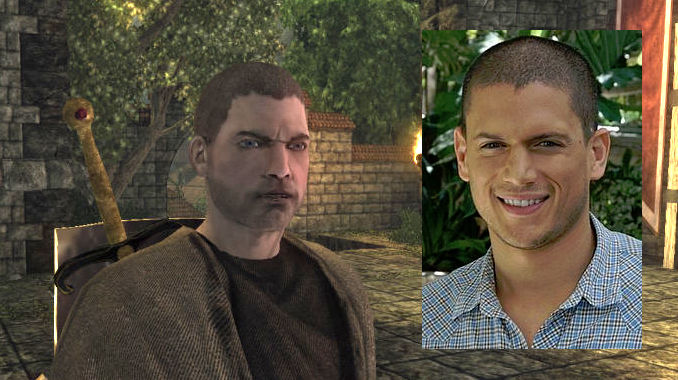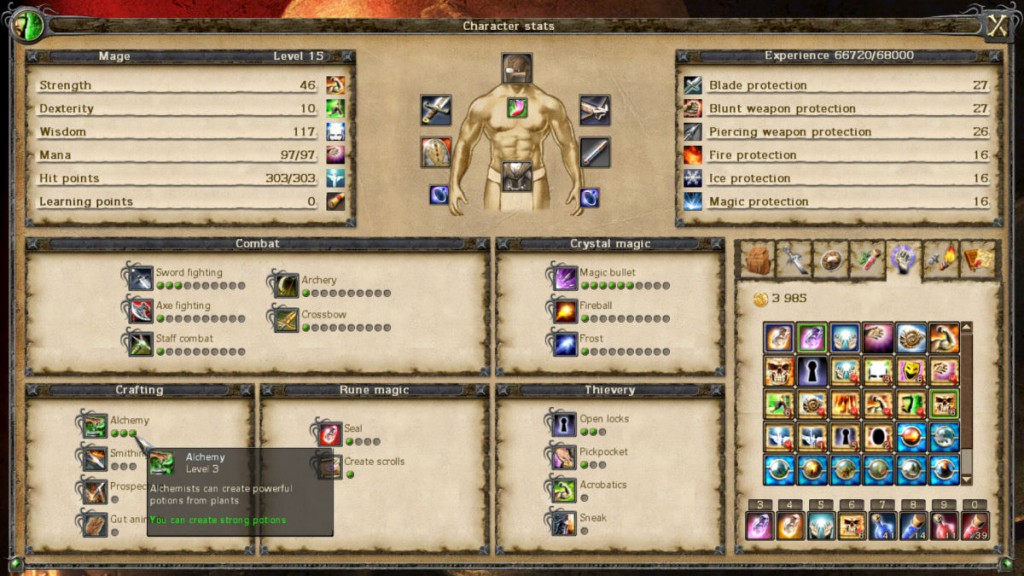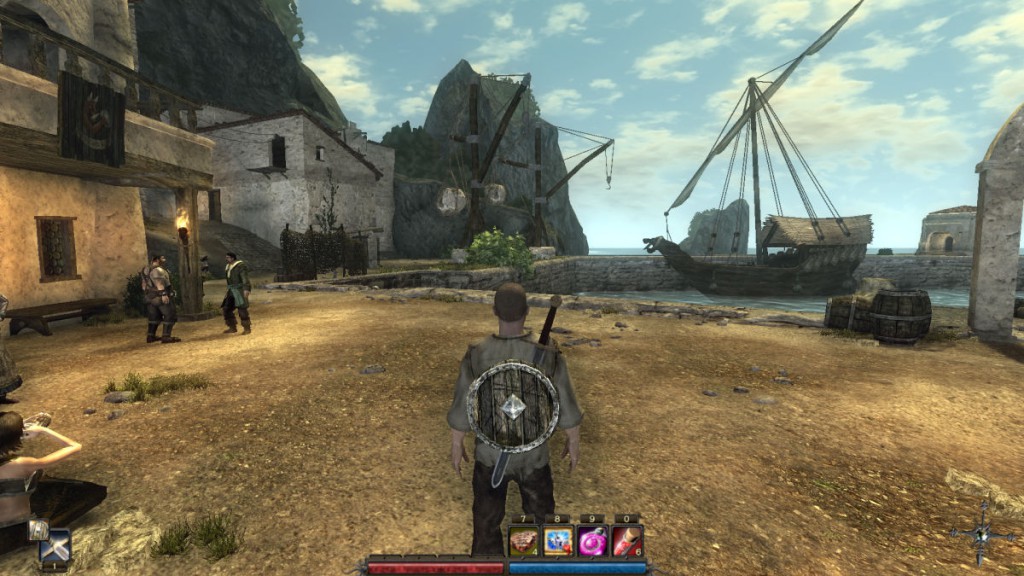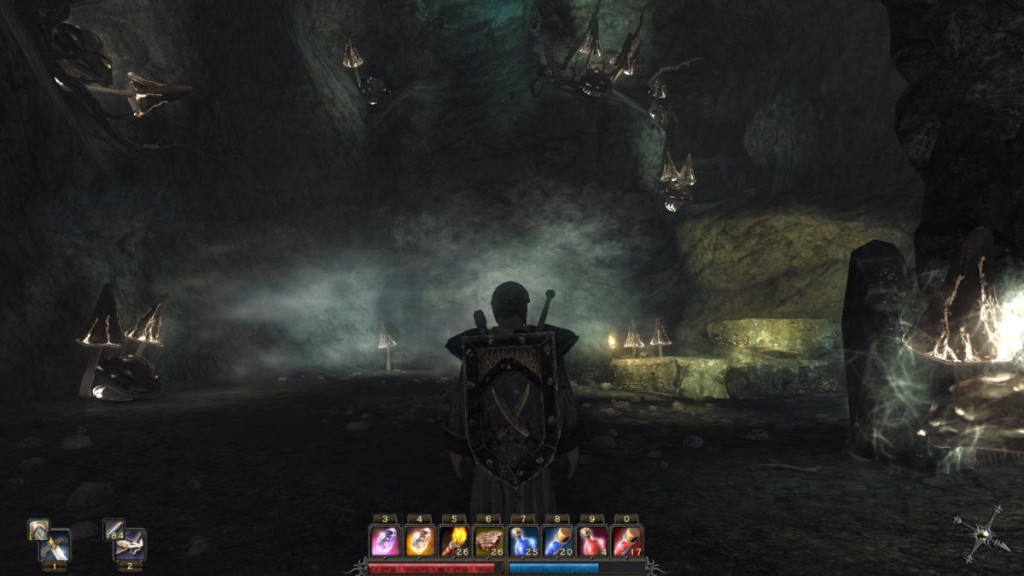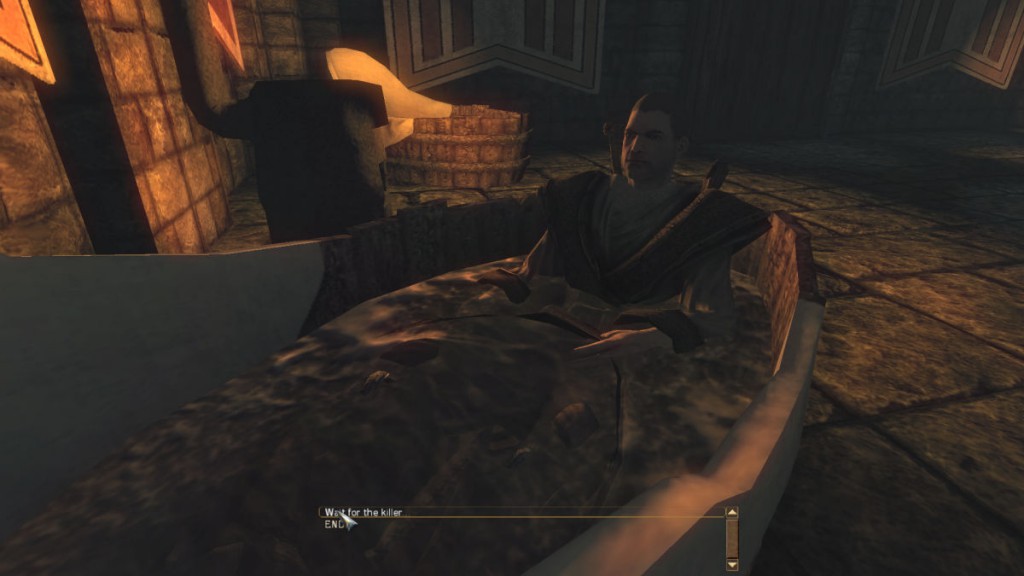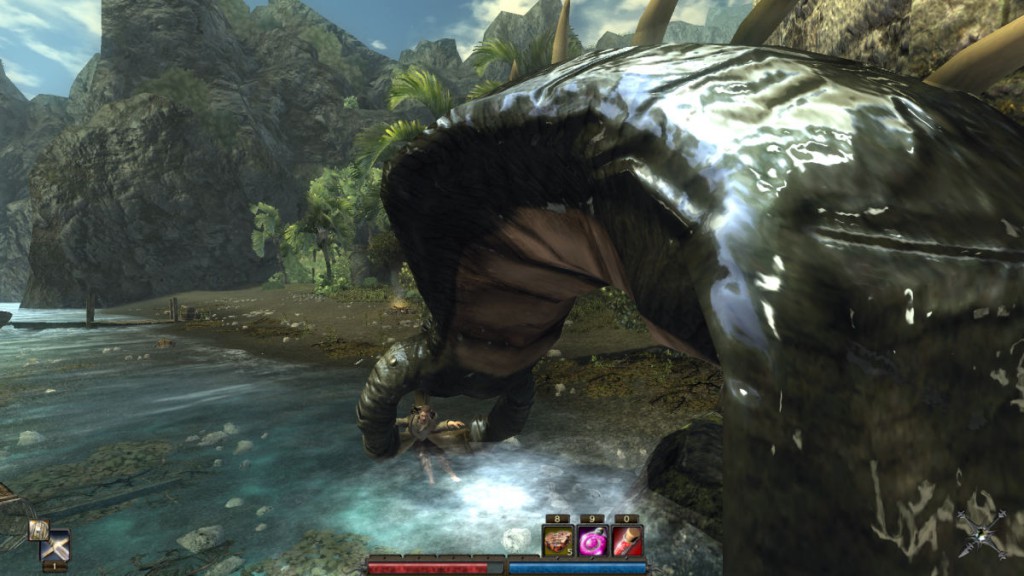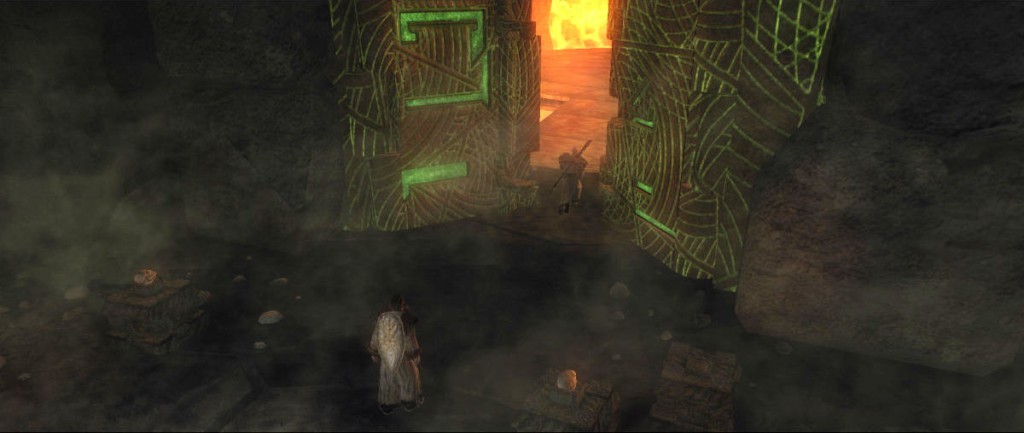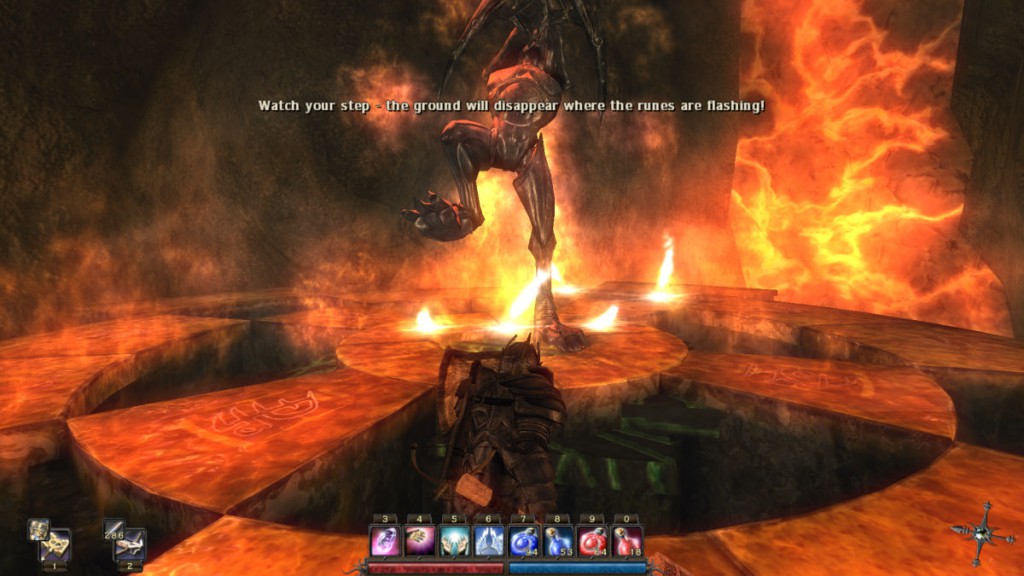Developer: Piranha Bytes | Released: 2009 | Genre: RPG, Third Person
This was a third person open world RPG in control of a predefined male human – no character customization in this one. It had ruthless beginnings, unforgiving combat, expensive training, no loading in and out of most houses and dungeons, a great sense of verticality in the form of steep cliffs and meandering paths, and NPC that sometimes wouldn’t restrain themselves from calling you a moron and optionally kick your ass if need be.
In other words, a typical Piranha Bytes RPG.
In fact, it felt so much like the first Gothic games that it could almost have been called Gothic 2½. I’ve completed the first three Gothic games a long time ago. (Well, actually I’ve completed all four if you also count Arcania, but it wasn’t made by Piranha Bytes and had a different feel.) The first games in the Gothic series had very ruthless beginnings. I actually never quite enjoyed starting that far down the ladder and it taking so long to get the upper hand, but there is something to be said for finally getting powerful enough to stand toe to toe with the tougher enemies of the game. It gives a very palpable sense of progression in the later parts of their games.
The Piranha Bytes RPG have always felt crude to me in a strangely charming way – kind of like the Paul Norman games on the Commodore 64, such as Forbidden Forest and Aztec Challenge. Lots of cut corners everywhere. Roasting a stew without meat in the pan. Animations where items are just conjured out of thin air. Sound effects that sometimes feel like they don’t belong. That sort of thing. Even though Risen was a reboot with a new publisher in 2009, it still felt totally like a late part of the exact same series. It also still had all the strong trademarks too, like a solid AI for NPC going about their own business.
Unfortunately, it also felt technologically archaic. Same crudeness, low polygon counts and mediocre human characters with disturbingly firm eyeballs. I constantly had to ask myself, did games still look this bad in 2009? But it was worth enduring the rough graphics and the lack of hand holding. After half a dozen hours I started sensing that very special Piranha Bytes atmosphere again. I’ve always been fascinated with their ability to build a world with that distinct style, and in that regard, Risen certainly didn’t disappoint. But it was also necessary because I really found the melee combat too unforgiving for my taste.
Combat has always been a bit of a problem in the Piranha Bytes RPG. Big chunks of health gone down for single hits even on the easiest difficulty level, and some games in the series have been plagued by stun locking – especially Gothic 3. In Risen, I absolutely had to have a good shield and used it for the majority of the melee fights. Enemies would often chain aggro together like in an MMORPG and surround me with their arbitrary flanking attacks. This often felt random enough that fights could go too south for me to bother anymore. Quickload. And then there were the fights where my health was smacked down; I would back off and drink a health potion, yet the bastard just smacked it down to the same level while the drinking animation was barely finishing. The latter was also a typical problem in Gothic 3.
However, I did get better as I got more strength and weapon skill, and I surprised myself later by actually enjoying a long fight against one very powerful staff master in the monastery. Timing and avoiding and retaliating against one humanoid opponent could be okay at times.
But as soon as a group of animals was involved again, it was back to disliking the combat. There were even times in the beginning where I jumped up on a tall rock and safely killed critters with a crossbow. Boy, did that feel good. I knew that I really wanted to have offensive magic spells to deal with them at a distance, but again Risen was merciless. I had to go through more than a dozen hours solving lots of faction quests before I finally got access to a mage trainer. A lot of the quests in the faction areas could be solved without combat, but once in a while it was still necessary to fight a human. Getting more strength and weapon skill for sword fighting (my weapon of choice) was not only prudent, it was necessary in order to stay on top.
Nevertheless, the wait for missile projectiles was worth the wait. I prioritized maximizing it and at level 10, almost all fights became a walk in the park. The spell had a minor staggering effect on enemies and even packs of the strongest lizard men or ogres would go down before they reached me – as long as I made sure to keep up my mana. Unfortunately it didn’t regenerate and I drank a ton of mana potions to make up for it. This was also a problem in Gothic 3, but at least it offered a regeneration ability later. Outside of MMORPG, I don’t think I’ve taken so many swigs of mana potions as in Gothic 3 and Risen.
The combat in Gothic 3 was even worse than in Risen and many gamers claim it’s generally the weakest game from Piranha Bytes, but it wasn’t all bad. Some things in Risen are quite the step backwards compared to that game. The most significant is the size and diversity of the world. In Gothic 3 there were three big zones that were quite varied – the southern desert, the temperate area in the middle, and the cold north. It felt like playing a single player miniature MMORPG with distinct zones and I really liked that. Risen took place on one volcanic island where the fauna was barely varied by woods and swamp areas. It felt like a much smaller world.
But one thing that really surprised me was the English translation. It wasn’t just translated from German, it was completely overhauled and rewritten with the English language in mind. And some of the actors used were even big shots such as John Rhys-Davies, Andy Serkis and Lena Headey. This made the dialog much more enjoyable and it was a good thing, because the NPC in this game sure were talkative. In fact, it was so excessive that I still clicked past a lot of the dialog just to get to the point.
One quest NPC actually kind of made fun of that. It was an alchemist that was a little hard to find in the monastery. He mastered the art of beating around the bush without ever figuring out what test to give me, and I couldn’t help but chuckle at that. Finally in the end, he settled with me finding two lost novices.
And that staff master I mentioned earlier? He threatened me with pulling my liver out through my nostrils.
Minutia
My predefined character looked almost exactly like Wentworth Miller from Prison Break, with a voice that sounded like a slightly bored Ewan McGregor. But that was all fine with me. I liked the idea of modeling the protagonist to look like a specific actor. I often tend to imagine the same thing when I’m reading books.
I mentioned the awful character models before, but maybe I should elaborate some more on that. I think there were less than half a dozen different models. The same constellation of hair and face used for several characters, sometimes with just a bit of slightly different clothing. In dialogs, both the protagonist and the NPC swayed their arms in a manner that was particularly noticeable because of the way this single animation was perpetually repeated. However, I believe I read somewhere that the developer was aware of this being a problem because they decided to start outsourcing the animation assets for the sequels.
I’ll keep that in mind for Risen 2.
The user interface was generally okay, especially compared to the first games in the Gothic series. The character screen even had a paper doll now, and I liked the way it listed all of the possible attributes at once – stats, magic, skills, even the inventory in the opposite corner. Just as in Gothic 3, the inventory had no weight or cell limits – I could just haul everything I ever wanted. No complaints from me there, especially after having completed Fallout 4 recently.
Not everything was excellent regarding the user interface, though. The map window required me to use a mouse pointer to click tabs for showing the world or local region, but moving the mouse pointer to one of these tabs also affected the mouse look of the game world – presumably because it allowed it to be used as sort of a minimap. The quest log was a bit convoluted and lazily just recorded a lot of dialog lines to sift through. Usually I just made a habit out of checking the quest characters several times in hubs. It fit nicely with the way I played the game anyway.
The lockpicking minigame also seemed like it was the victim of being on a low priority during development. Instead of using tools, maybe with a keyhole or a cut through a lock cylinder, I was merely offered a row of left or right arrow icons. Hit left and right movement keys, guess wrong and restart. Guess wrong too many times and the lockpick breaks. Left and right icons were always evenly distributed, making it easier to guess the rest as the icons fell into place.
I can’t imagine it was hard to code that minigame.
Similarly, the pickpocketing was barely a minigame at all. No sneaking, no danger of being discovered. I only took one level of pickpocketing out of three, and with that level I just got an extra dialog option for provoking the NPC. While the NPC answered, I could grab one item out of their inventory while a slow timer bar went down. There was no additional fail option at this point. But if the pickpocketing level was insufficient, Wentworth Mi… I mean, the protagonist, just whispered “too risky” and that was it.
To be honest, I can’t really complain about the way they made the pickpocketing easy. I usually always skip this ability in RPG as I hate being caught in the act because of some wonky sneaking variables, and it also goes against the type of character I usually roleplay. Nevertheless, I still used it in Risen. Why? Partly because one guide on the internet recommended it wholeheartedly as something that was almost mandatory, but also because it was the lesser evil of a chain of quests in the bandit camp.
I had to acquire five pieces of a sword for a blacksmith to be allowed to talk to the bandit leader Don Esteban, but after getting the first four it turned out that the last piece was in possession of a nasty bandit bastard that wouldn’t give it up. I had two options to solve that one. Either go through a long line of arena fights, with him being the last one of them, or pickpocket him. If you’ve read my blog post about Worn RPG Tropes you’ll know how tired I am of arena fights. I’ve done these so many times in RPG and I just couldn’t be bothered to do it again in Risen. So pickpocketing it was.
Moving from the in-game user interface to the settings, I found a couple of lamentations there too. Apart from not having a slider for adjusting the mouse sensitivity, I’m starting to get really annoyed by developers not allowing me to reassign that damn quicksave hotkey. I always want to move this to Keypad Plus because it makes it much easier to tap it quickly with my mouse hand thumb. Besides, F8 for quicksave and F9 for quickload is just asking for trouble. I’ve read forum post by angry gamers about how much progress they lost because of hitting the wrong key. Luckily I could change the binding in a configuration file, but I really shouldn’t have to resort to that.
If there are quicksave and quickload keys, please allow us to reassign them.
I loved the nature of the gnomes in this game. Small, rotund tyrants that almost disappeared in the tall grass, and they loved to throw all kinds of trash at me. I couldn’t ever get too angry at them. Unlike most of the pack animals – especially wolves. I always hated fighting those in melee.
And pigs loved to roll around in the dirt.
It’s funny how different stealing is in Piranha Bytes games compared to those from Bethesda, such as The Elder Scrolls series. In e.g. Skyrim, stolen goods had red text and it was hard to sell – usually I needed a fence. Items were not marked in red text in Risen and a rare once in a while it was even hard to determine whether it was okay to grab stuff from chests and cupboards in a house. A homeowner would sometimes come running inside to either keep an eye on me or ask me to get the fuck out. If I was fast, I could empty a chest in a jiffy and maybe even sell it to the homeowner himself if he was also a merchant.
Only if he actually saw me take his stuff would he get violent.
So in games like Skyrim I usually always stayed on the right side of the law and practically never stole anything, because I didn’t like the way merchants just “knew” when something was stolen. In Risen, I always opened a chest if no one was around yet. Sometimes I was smacked around a few seconds later as punishment for me not paying attention to my surroundings, but then I just quickloaded and either forgot about the chest or was even quicker about it.
Most of the time I didn’t use a ring with Acrobatics +1 and I certainly never bothered to spend points on the ability to survive big falls with a roll. Almost all drops from big heights just sort of went through a big, invisible staircase instead that prevented me from taking any damage. The only rule was to walk over the edge, not jump. It was one of those bugs where for once you’re actually happy it’s there. I can’t tell if it was the Steam version I played that had this bug, or if my new PC from 2015 did something weird.
Unfortunately, there was another related bug in the game that was pretty annoying at times. The hero could climb up on edges by pressing the jump key, but sometimes it was as if he only climbed 80% of the way and was then stuck inside the graphics, subtly shaking the entire level forever. Most of the hotkeys didn’t work when this happened, except the quickload key – thank goodness for that. This was so aggravating that I gave myself plenty of levitation spells via the console.
The pathfinding and NPC AI often impressed me in the Piranha Bytes RPG, but I really had my socks knocked off several times in Risen. There was this skeleton that could be spawned using a spell scroll and fight for you. His name was always Fred, and he was often a useful melee tank while I shot missile projectiles. However, commands for the skelly was very sparse – wait or follow, that was it. No dismissing. So sometimes I managed to jump down somewhere that poor Fred didn’t know how to deal with, or I left him behind as I used a teleporter stone to the opposite end of the island. Sometimes I never saw Fred again, but sometimes he actually came and joined up again several minutes later, as if he found an alternative route around half the island. Or he would just stand in the same spot I left him as I teleported away several hours earlier, ready to join up for more tanking. Damn impressive.
Some things in Risen reminded me of other games in peculiar ways. Sometimes I could hear the roar of an ashbeast or lizard men through a wall. Not only did this teach me that there was something to be found in there somewhere, it also made me think of similar wall sounds in the classic Doom games. And a swamp area close to the eastern temple made me think of a similar swamp area in Vietcong.
Conversely, there were also a few unique ideas. There was a spell that shrunk me down to a small size, useful for getting past a wall through a tiny hole. That idea in itself wasn’t unique, but the animal I was changed into sure was – a small snail-like nautilus. And it was possible to take a bath in a tub without taking off my clothes first. It looked like something out of Monty Python as he just sat there.
But what was up with that occasional thunderstorm? I know it was supposed to be a magical phenomenon only on this island, but even so it was still completely ridiculous. I’ve never seen thunder and lightning occur so frequently – it must have been several strikes every second. Also, sometimes it was as if certain hotspot zones on the island would trigger this weather.
Dungeons were dark and very atmospheric, but also cramped at times. Sometimes I couldn’t see the enemies in a room before I actually popped in there. A light spell or a torch was often indispensable. Especially the dungeons in chapter 3 and 4 could get quite big and non-linear, and there were sometimes puzzles such as levers to affect from a distance with a telekinesis spell to avoid getting killed by a fire, spear or piston trap. But the style and darkness of the dungeons contributed to that special Piranha Bytes atmosphere and I didn’t mind the abundance of them in the later chapters.
Classes were connected to factions in the game and required a lot of questing. The bandit camp was for melee fighters while the Warriors of the Order could give access to either a Paladin sort of class or a strict Mage. The Order was mostly hostile in the first chapter and getting captured by them both meant being forced to become the Paladin sort while also missing out on a lot of quests. So needless to say, it made a lot of sense to avoid getting captured and have a class plan.
However, this was made quite annoying when it came to entering and leaving Harbour Town in the first chapter, an important quest hub. The Order was guarding the front gate and would immediately grab me on sight. Apart from entering once through the back door with a bribe, I had to exploit jumping on rocks in the corner of a plateau overlooking part of the town. Getting out of the town that way was easy, but getting in often required several retries after falling down. A tall palm tree complicated matters by making it difficult to see where to jump.
The strange thing is that as soon as I was inside the town, the Order no longer tried to catch me.
But wait, couldn’t you just have snuck in from the sea side? Not possible. As soon as I entered deep water, a ginormous sea worm loomed over me, grabbed me like a nut in its monstrous jaws, then threw me back on the beach. It could easily have eaten me – I guess Piranha Bytes paid it top dollar to just guard the ocean.
I quickly decided to go for a Mage class, so I did the seven key faction quests in town on the side of the Order. The boss of the town, Carlos, then thanked me with a written recommendation. From then on the Order stopped bolting after my hide and I took the tests in their monastery to become a Mage. I was level 10 before I was finally put through the initiation that gave me the crystal magic needed for the offensive spells. It sure was a long wait to get access to that basic stuff.
In chapter 2, the main task was to find five crystal disks for a gate into the mountain. I got the first four disks done quickly, one of which involved following a tame wolf named Rufo while it tracked down a kidnapped mage. But the fifth disk really evaded me. After a couple of long sessions, a deep stare into the quest log revealed that I still had to check out the chest of Patty’s pirate dad in town. It was okay being stuck for a while though, because it made me parse the island for odd caves and get a lot of extra XP by killing tons of creatures. Every cloud has a silver lining.
Patty’s quest was about finding five treasure chests all over the island, all of which I had already dug up earlier. And then she was kidnapped by Romanov and his gang. I just knew this would happen, but it probably wasn’t hard to guess in the first place. I let him tell me where she was, found Patty’s map, and then I killed them all.
I wonder if there will be quests surrounding this map in Risen 2?
The enormous and non-linear dungeon in chapter 3 was explored by the Inquisitor and I, together with a dozen of his men. Sometimes a big gate or a drawbridge would bring the big party to a halt, typically after having fought a horde of lizard men. I then had to puzzle around and figure out how to get the party going. Finally, I found a Titan Lord ghost named Ursegor. I helped him escape his imprisonment by killing three easy mini bosses. In return he helped us by offering his own skull for opening a big gate to the central part of the dungeon. And that’s where the Inquisitor turned bad guy and ordered his men to attack me while running off and locking the gate behind him.
As I knew would happen all the time. But again, it probably wasn’t hard to guess in the first place.
Chapter 4 was about finding parts of a Titan Lord armor suit in five dungeons scattered around the island. The dungeons varied a lot in size. One was very tiny and took only a couple of minutes to do, while at least two other dungeons were almost as big as the one in chapter 3. I was surprised to find a mini boss in the small dungeon, a skeleton with a Titan axe, that was almost invulnerable. He could only be killed by luring him across a fire vent that I turned on with a timely shot at a distant button. Lots of kiting here.
Puzzles also grew a tiny bit more interesting in the chapter 4 dungeons. Running below timed piston traps, a spear board section (very traditional) and grabbing hold of a golden bust via telekinesis to avoid a gate closing shut behind me. In one place I was stumped for a few minutes until I discovered that repeated clicks on the same button opened two other doors in three binary constellations. It was the only place in the game where I saw this exception.
In a couple of places, green crystals created a local zone around them where magic wasn’t possible. My magic light sphere immediately fizzled out. I was glad that the developers only used this sparingly, because it also prevented me from using the levitation spell to circumvent that climbing bug I mentioned earlier. Luckily I didn’t have to fight any creatures in areas without magic. In one damp part of a dungeon I just lured a lizard man closer to me by shooting him once with my crossbow, after which my missile projectiles easily finished the job.
And finally the boss fight. I read about how most gamers disliked this fight and I had somewhat prepared myself mentally. Most of all I was afraid that there would be those green crystals present to prevent magic while requiring me to climb edges (that would have been a showstopper) but thankfully that wasn’t the case. Instead, I fought a Titan Lord in the center of a circular set of platforms. Sometimes the platforms faded away and I had to jump to avoid dropping into lava. The boss could shoot out a sweeping beam I had to outrun, he could stomp a sphere for me to jump up from, or he could shoot out a cluster of magic bullets. This was the only part I could use offensively by reflecting them with my shield, bringing the boss to his knees. I then had to be fast and swing my mighty axe at him. Seven hits like this and it was all over.
It felt like the developers had borrowed a few raid boss rules from MMORPG and it was a little frustrating while learning the ropes, but after a few tries and paying attention to the fading platforms, it actually wasn’t that bad. I’ve seen way more difficult end game bosses in my gaming life. But it’s true that it completely bypassed all rules, as if the sequence belonged in a totally different game, and that the boss didn’t react to any other damage than right after reflecting his magic bullets. There was a while in the beginning where I just kept hammering him and couldn’t tell if it mattered at all.
I managed to reach level 28, probably because of being stuck while searching for the fifth disk.
| TitleLength | Dates | Diff / Cht | Save | Score | |
|---|---|---|---|---|---|
|
Risen
2009 Piranha Bytes38h 45m 11
|
2016-02-03 2016-02-16 |
8
|
![]()


